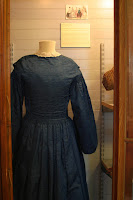This month we're happy to have a guest post from our archival intern Caleigh Ross. Caleigh has just finished processing a new donated collection about the lives of some fascinating Natick residents:
Newly
Opened Collections:
Erica
Ball Personal Papers and Jay Ball Personal Papers
The Natick Historical Society is pleased to
announce that the Erica Ball and Jay Ball collections are open and available
for research.
Erica
Ball
Erica
Esther Weisz (Ricky) was born in Vienna in 1937. She and her parents emigrated
to Trinidad in 1938. When she was ten years old, Erica and her parents moved to
Passaic New Jersey, where she attended high school before attending Brandeis
University. She married her husband, Jay Ball, in 1958, and had three sons:
David, Alan and Jonathan. David became a nurse and a Lieutenant Colonel in the
United States Air Force, and Alan is a professional actor in Chicago. Their son
Jonathan was killed in a school bus accident in 1967, and the tragedy
galvanized their efforts to ensure greater school bus safety measures. Their
‘no standees’ initiative is now state law, and many communities employ the
school bus monitor concept they promoted.
Ball
entered politics by way of the League of Women Voters (LWV), which she joined
in 1967 and in which she was a driving force for 21 years. She served as
President of the Natick LWV for two terms, playing a major role in the
formation of the Lake Cochituate Watershed Association, and serving on the
League’s State Legislative Committee from 1972 to 1974. From 1968 to 1980 she
represented the League on the South Middlesex Opportunity Council (SMOC), an
agency that she later served as President (1974-1975) and Vice President
(1976-1977).
In 1975
she campaigned for a seat on the Natick Board of Selectmen, and became the
first woman in the town’s 350-year history to serve in that capacity. She has
been a Natick Town Meeting Member since 1973. Ball served on the Natick Ad-Hoc
Day Care Committee, initiating and coordinating efforts to offer extended day
childcare in Natick.
An
inveterate political campaigner, Ball has actively participated in and
volunteered for countless campaigns, including her husband Jay’s campaign for
Natick’s Board of Selectmen in 1997. Ball was a founder of The Center of the
Arts, a growing and vibrant venue for the performing and visual arts, located
in downtown Natick, and continues to remain actively involved as a member of
the Board of Directors, focusing on Development. In 2010 Ball ran for a
position on the Board of Commissioners for the Natick Housing Authority, and
continues to serve on the board.
Ricky
Ball’s numerous contributions to the Natick community, infrastructure, and
people are reflected in her newly processed personal papers. The collection
contains correspondence, photographs, news clippings, notes, and ephemera related to Ball’s extensive work in local
government and service organizations, including the town of Natick’s Board of
Selectmen, League of Women Voters, and Housing Authority, among others. This
collection also contains letters, memos, and reports created during her 1982
campaign for Massachusetts State Representative. Through her collection, researchers can learn about the challenges
that Ball faced, the pitfalls she experienced, and the victories she enjoyed
throughout her long career. This collection also serves to promote a deeper
understanding of the shared experiences of female politicians and community
organizers in the late twentieth century.
If you would like to explore the Erica Ball Personal Papers, please feel
free to call or email to make an appointment!
Jay Ball
Jay Ball
was born in 1935 in Brooklyn New York. He completed his primary and secondary
education in New York before attending Massachusetts Institute of Technology (MIT).
He graduated from MIT with a degree in engineering in 1956, and married his
wife Erica (Ricky) that same year. Jay received his Masters degree in
engineering from MIT in 1961. The Balls had three sons, David, Alan, and
Jonathan. David became a nurse and a Lieutenant Colonel in the United States
Air Force, and Alan is a professional actor in Chicago. Their son Jonathan was
killed in a school bus accident in 1967, and the tragedy galvanized their
efforts to ensure greater school bus safety measures. Their ‘no standees’
initiative is now state law, and many communities employ the school bus monitor
concept they promoted.
In 1997
Jay campaigned for a seat on the Natick Board of Selectmen. He served three
terms as a Selectman from 1997 to 2006. As a Selectman, he was an integral
force behind the creation of the annual Natick Days event, and also served to
facilitate the transition when the Town Administrator passed away in 2002. Ball
has also been actively involved with the Temple Israel Congregation,
particularly as a member of the Ark Builders, who have built and donated
several woodworking creations to the Temple and to the local community.
Personally,
Ball is an avid photographer and actor, participating in many of The Center for
the Arts Natick (TCAN) productions. His photographs have been featured in local
exhibits and newspapers, as well as in the Old Town Calendar.
The Jay
Ball Personal Papers contain documents, correspondence, photographs, news
clippings, notes, and ephemera related to Jay Ball’s extensive work in local
government and service organizations, including the town of Natick’s Board of
Selectmen, the Temple Israel Ark Builders, and the School Bus Transportation
Safety Study Committee, among others. This collection also contains materials
relating to Ball’s business interests and personal interests, in photography
and theater. Through this collection, researchers can learn about the work, the
interests, and the activities of one of Natick’s true Renaissance Men. If you
would like to explore the Jay Ball Personal Papers, please feel free to call or
email to make an appointment!

























